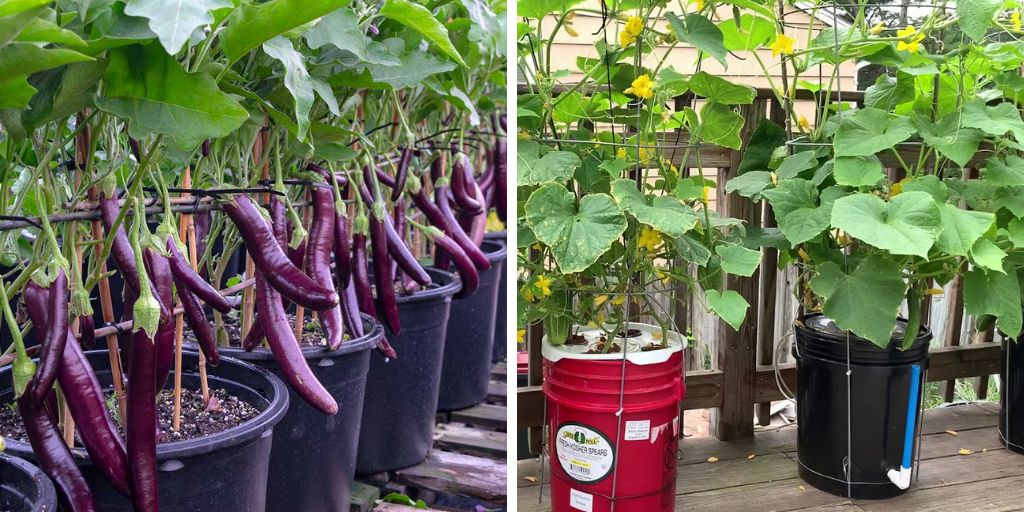A 5-gallon bucket can serve a wide variety of purposes. They have a wide variety of uses around the house and farm.
Growing crops is a natural application for these recycled containers. It’s possible to grow a wide variety of fruits and vegetables in 5 gallon buckets.
In this article, we’ll look at some of the most popular options, along with advice on how to maximize your chances of success.
Tomatoes
When it comes to choosing what to cultivate in pots, tomatoes consistently rank high on the list. Tomatoes grown in a bucket can be brought indoors or protected from the elements if frost is in the forecast.
This allows green tomatoes more time to ripen and can extend the growing season in cooler regions.
Keep your tomato plant count in a 5 gallon bucket to a minimum by never planting more than one plant in there at a time. In addition, you may want to consider supporting your tomato plants if you are cultivating vining varieties rather than bush forms.
When blooms and fruits appear, mulch your tomato containers with comfrey leaves to increase fertility and decrease water need. Additionally, increase fertility and harvest size with comfrey liquid plant feed.

Peppers
Peppers, which likewise thrive in the summer heat, are a member of the same plant family. Thanks to their shallow roots, they thrive in pots. As the season winds down, these, too, can be brought indoors or under protection in regions where frost is a concern.
Peppers, specifically dwarf kinds, could be grown in even smaller containers. On the other hand, a 5 gallon bucket is ideal for growing most types of sweet and spicy peppers.
Remember that pepper plants prefer relatively high humidity, so in addition to watering, spraying foliage and dampening down nearby hard surfaces can be helpful when conditions are dry.
While you should only put one pepper plant in a 5 gallon bucket, you could put three dwarf types in the same container. Along with a handful of tiny herb plants, you might also plant one smaller pepper plant. Companion plants that share an aromatic quality, such as basil and oregano, can be quite useful. Garlic, scallions, or chives would be great additions to the bucket’s rim.
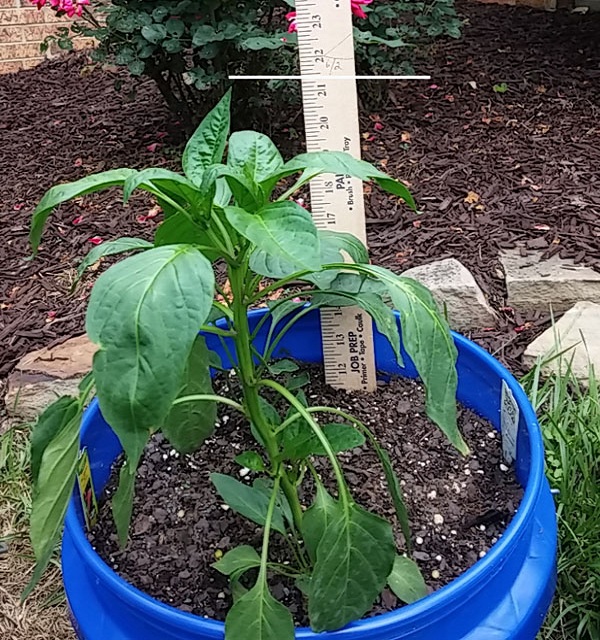
Eggplant
Eggplants, like tomatoes and peppers, are members of the nightshade family and may be grown readily in pots.
It’s possible to grow a single plant successfully in a 5 gallon bucket if you take care to fertilize and water it thoroughly throughout the summer.
Similarly to how tomatoes benefit from supports, your plants will benefit from having them in place while they create and grow their fruit. Some dwarf types, such the ‘fairy tale’ and ‘little finger,’ are ideal for growing in pots, and for eggplants with smaller fruits, growing them upside down may be an alternative to maximize limited space.
Tip: Allow for adequate drainage; the optimum eggplant growing media is 2 parts ordinary potting soil to 1 part sand. This more permeable mixture still contains sufficient nutrients, but it allows excess water to evaporate.
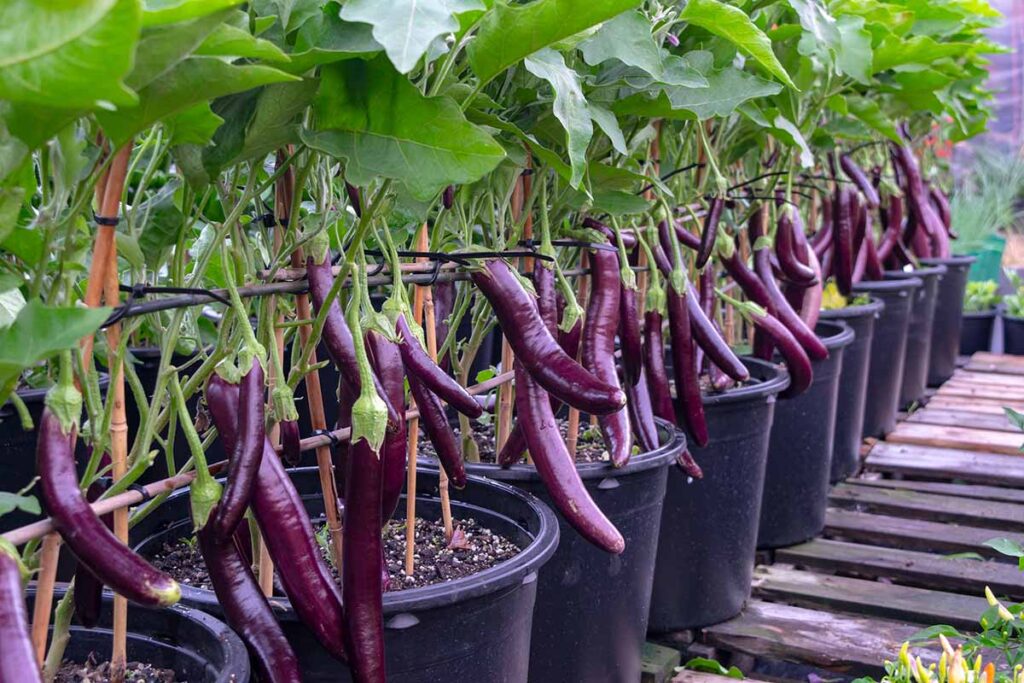
Zucchini
Zucchini (and possibly other types of summer squash) can thrive in 5 gallon buckets since they have a roots structure and growth pattern similar to eggplant.
However, keep in mind that these are rather thirsty and hungry plants. Because of this, you should fertilize and water your plants regularly (though excellent drainage is also essential).
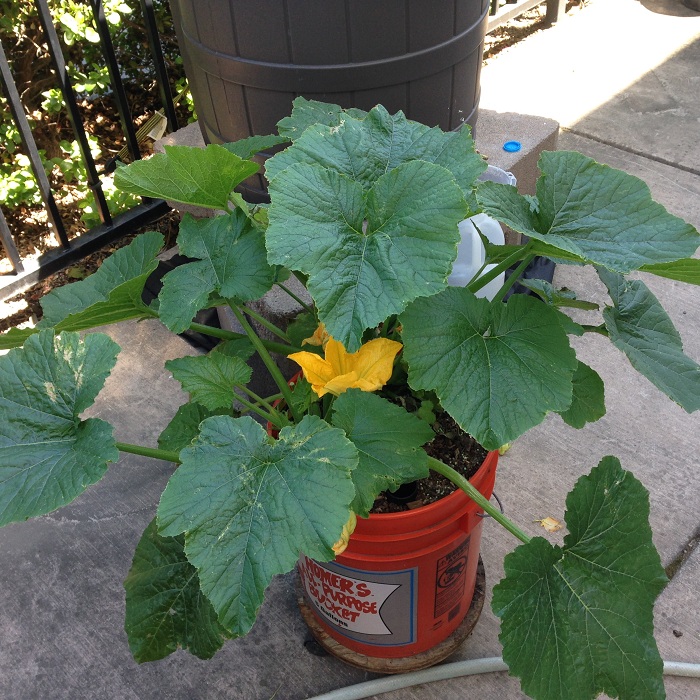
Cucumbers
Similarly, cucumbers are a crop that can be grown easily in a 5 gallon bucket. Vining cucumbers, even those that get quite large, can be grown in a 5 gallon bucket if they are planted beneath a trellis or some other support system that they can use to climb as they mature.
However, bush-type cultivars are your best bet when it comes to growing cucumbers in containers because their vines stay a manageable 2–3 feet in length. Two can be planted in a single container.
Picking one of these strains is a smart move if you’re a beginner gardener or have never grown cucumbers in pots before. The terms “Burpless bush,” “Picklebush,” “Salad bush,” and “Bush champion” are all possibilities.
Tip: Cucumbers don’t usually transplant well. To plant seeds directly: (planting two groups of three seeds and removing extra seeds after germination). To avoid disturbing the plant’s roots while seeding indoors or elsewhere, use biodegradable pots that may be buried in your 5-gallon bucket.
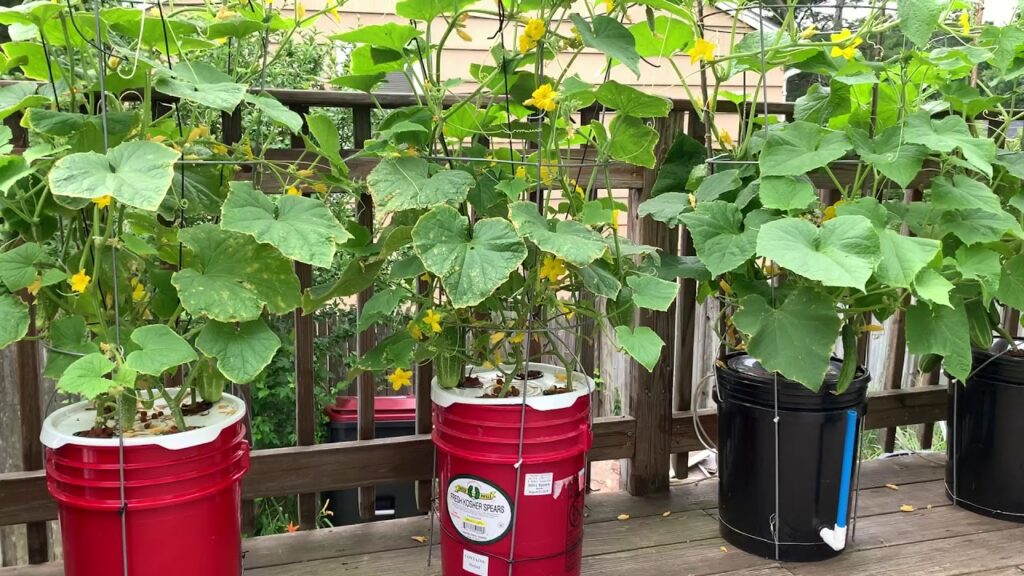
Lettuce & Other Leafy Crops
Loose leaf lettuce is an excellent choice for first-time gardeners and those just getting started with container gardening.
Simply scatter the seeds over the top of the growing media in the bucket, leaving a distance of half an inch to an inch between each seed. Then, for cut and come again plants, thin to 3-4 inches apart, and wider apart for more mature plants or headed forms.
Leafy greens like arugula, Asian greens, leaf mustards, spinach, and chard are just as simple to cultivate as lettuce. These plants don’t require the entire depth of a 5 gallon bucket. In that case, you can think of using a bucket and making openings in the bottom and sides of it. This allows you to maximize your harvest from a limited area by planting leafy greens in the holes.
Tip: While the weather is warm, give your leafy plants a nitrogen-rich plant feed. If you’re growing lettuce in buckets, radishes and scallions make excellent companion plants. Or, any edible flowers or herbs.

Kale, Broccoli & Other Brassicas
The extra room in a 5 gallon bucket is great for growing larger, leafier plants. Individual plants of kale, broccoli, or cauliflower can be cultivated in their own buckets. With kohlrabi and other small plants, you will have room to grow more than one.
Growing larger leafy crops like these in 5 gallon buckets has the added benefit of being easily portable, which is especially useful in warmer climates. The ability to relocate plants is also useful in other colder regions, particularly during the transitional periods between growing seasons.
To keep birds and cabbage white butterflies away from your brassicas, you should definitely net them. However, you may easily construct mesh cages around individual pots, or group buckets together and cover them with a row cover.
Brassicas require a lot of fertilizer, so use a decent growing medium with a lot of high-quality compost mixed in. As an additional step, you may mulch each plant with grass clippings, compost, or other nitrogen-rich materials. A nitrogen-rich liquid feed can also be used to nourish plants.
Tip: plant lettuce around young brassicas. Before the brassica plant grows too large for the bucket, the lettuces can be harvested and consumed.

Onions
Growing full-sized bulb onions in a 5 gallon bucket might not be the best idea. You can probably only produce around three to five onions in each. But there are many varieties of onions beyond the common bulb onion that can be grown. Some species do far better in a bucket than others do.
As was previously indicated, lettuce and scallions can thrive when planted together in a bucket. They are also useful for edging various types of plant containers, such as buckets.
Smaller alliums, such chives or scallions, can be grown in close proximity to carrots to cover their aroma and confuse pests like carrot fly.
Tip: Along with other perennial plants, bunching onions, chives, and other varieties of perennial onions can be grown in a bucket. You can grow food-producing perennials in buckets for more than one growing season if you give them regular fresh compost or mulch and liquid fertilizer.

Carrots & Other Root Vegetables
A number of different root crops can also be grown in 5 gallon buckets. Carrots of all shapes and sizes can be grown effectively in a 5-gallon bucket since its depth is sufficient for accommodating even extended roots.
In comparison to many other major crops, carrots have minimal dietary requirements. However, they require a growing medium that is both lightweight and easily drains. You can make sure the bucket drains better by adding sand to the potting mix.
Aside from carrots and potatoes, a 5 gallon bucket can also house beets and parsnips. Beets, however, have higher nutrient needs and hence require more water, more space, and slightly richer soil.
Growing root crops in succession will extend your yield and make better use of your time and space. When the bulbs of your beets first start to form, feed them a compost tea.

Potatoes
If you only want to grow one potato plant, a 5-gallon bucket will do the trick. Although it may not seem like much, you can harvest ten potatoes from just one planted potato. Thus, you won’t have to use as many buckets to collect a significant amount.
Don’t fill the bucket with soil until it’s almost overflowing if you’re planting potatoes in it. Instead, fill your bucket about a third of the way with your growth medium of choice, and then set a seed potato on top of it, eyes or chits facing upward. Next, add another two to three inches of the nutrient-rich growing media on top.
Don’t ‘earth up’ the plant until the seedling is fully developed. In other words, surround it with extra growing material. Doing so will stimulate the development of side shoots from the parent tuber. Comfrey is another great addition, both in the form of mulch (the leaves) and liquid feed (the stems, roots, and leaves) to promote healthy development.
Tip: Be sure to water your potatoes regularly, but especially during the drier, hot summer months.

Peas
Insert a twiggy stick with plenty of roots into the growing material at the center of the bucket. Plant a row of peas around the foundation.
Peas should be planted about 2 inches apart and 1 inch deep. To avoid having your container topple over from overly tall plants, it’s best to stick to dwarf bush kinds.
Keep in mind that the younger plants can be picked for their delicious pea shoots to be used in salads, larger ones can be saved for later harvests of mange tout, snap peas, or shelled peas.
Don’t let the soil dry out completely, but don’t overwater either, or you risk root rot. Using compost as a mulch might help to keep the soil moist.
To avoid pulling up the entire plant, simply snip the peas off at the base when they are done. Then you can plant nitrogen-loving plants in the same container. (Peas are a type of plant that can fix nitrogen.)

Beans
5 gallon buckets could also be used to cultivate other nitrogen-fixing plants. Every bucket may accommodate a single bush bean plant. If your bucket is supported by a trellis or some other structure, you might also plant a couple of climbing or vining beans in it.
Soil moisture is also important for growing beans; give the plants lots of water when they’re in bloom and again when they start to produce pods.
Tip: Consider positioning a row of 5 gallon buckets between two posts. Connect the posts with wire or a pole, and lower another into each container. Runner beans and other climbing beans can be grown vertically up each one to maximize yield in a constrained space. Climbing beans can also be grown in a short space by constructing a tipi or wigwam out of three canes.

Strawberries
Growing strawberries is a breeze, and you can harvest a large harvest from only one 5-gallon bucket.
Like with lettuce, you could drill holes on the side of the bucket to make more room for sowing strawberry seeds.
Strawberries need to be watered well, but the medium should be reasonably free-draining. When the plants are blooming, feeding them a high-potassium fertilizer should assist boost production.
Tip: A few strawberry plants, together with other wonderful companion plants like borage, thyme, sage, etc., could thrive in 5 gallon buckets used as mixed planters.

Blueberries & Other Fruit Bushes
Another soft fruit that works nicely in 5 gallon buckets is blueberries. Due to the necessity for ericaceous (acidic) soil, blueberries are often grown in containers.
Therefore, amending a bigger area of soil in a garden is more difficult than growing in a bucket in an appropriate growing medium (with a pH of around 5.5).

Raspberries & Other Fruit Canes
Each bucket may hold one raspberry cane or any soft fruit cane. A strong central stake is required for each one. As you emerge, connect your canes to this pillar. This method works for practically every kind of raspberry imaginable.
However, a dwarf variety may provide the greatest benefits for your situation. You could go with a dwarf, thornless variation like the “Raspberry Shortcake” if you wanted to. Only a few feet in height, at most.
Use compost or similar thick organic mulch to help keep moisture and nutrients in the soil. In addition, proper raspberry pruning is essential for fruitful growth.
These 15 container-friendly fruits and vegetables are only the tip of the iceberg. A garden in a container can be just as diverse, productive, and intriguing as a garden in the ground provided you pay attention to your climate and the needs of the plants you choose to cultivate.

Tips & Recommendations
For starters, remember the plastic buckets need to have holes at the bottom for water to pour out. While some plants have more stringent drainage requirements than others, all plants require a means for excess water to drain away.
Consider installing “feet” or other support structures under your containers if they are going to be set on a hard surface; this will allow water to drain more efficiently.
It’s also important to remember that the buckets’ colors matter. Buckets of a darker color, like black, will absorb and hold heat, while those of a lighter hue will reflect the sun’s rays and remain cooler. This means that, in most temperate zones, white or pale buckets are optimal for summer growing, while black buckets may be preferable for early spring/fall/winter growing in colder locations.
Where you put your buckets also matters. Thus, that is also a crucial consideration.
Why Use 5 Gallon Buckets to Cultivate a Garden & Where to Find them?
Five gallon buckets are great. You can fit a lot of these on a patio or balcony because they are deep enough for most plants’ roots but narrow enough to fit in a tight spot.
If harsh weather threatens your plants, you can easily bring them inside in their five-gallon containers.
If you know where to look, you can find them for no cost at all. Check with nearby businesses like bakeries, delis, and restaurants to see if they have any spare 5 gallon buckets lying around. These places of business frequently get food in 5 gallon buckets for bulk delivery. In addition, you can safely cultivate your own food in the buckets if their past use involved food.

